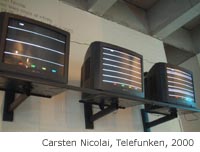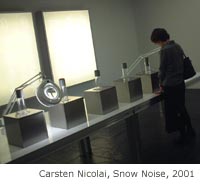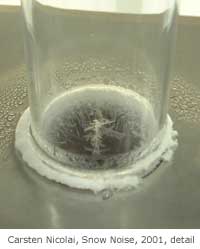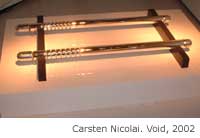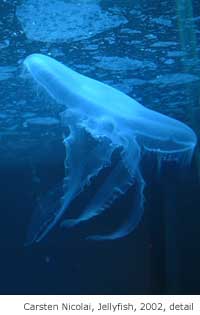
Both science and art involve a search for 'truths' in the world around
us. They also both recognize creativity as vital to their disciplines.
However, in spite of these similarities they seem to look from different
angles and find very different solutions. Art, gazing through a spiritual
lens, has tended towards the metaphysical. While science, with an analytical
microscope, focuses on the physical.
German artist, Carsten Nicolai, uses the apparatus of science to uncover
a poetic view of the world around us. His exhibition, at The Watari Museum
of Contemporary Art, incorporates dataflash systems, vacuum tubes, audio
signals, television monitors, jelly fish, tape recorders, microphones,
light boxes, dry ice and numerous other pieces of equipment sourced from
the laboratory to help him achieve this.
Nicolai has a particular interest in sound. In 1995, he founded the "noton"
record label, which features electronica music. This label (now 'Raster-Noton')
has released over 40 CD's including many of his own soundscapes. He has
performed at music festivals as well as major museums throughout the world.
While in Japan he is collaborating with musician Ryuchi Sakamoto on a
new project. The Watarium exhibition includes installation pieces made
by Nicolai over the past three years. Snow Noise, 2001, was made in collaboration
with physicist, Ukichiro Nakaya, a leading expert in snow crystals. In
the installation, we are able to listen, as well as, watch the formation
of snow crystals in plastic tubes which are housed in freezing stainless
steel containers.
In his piece 'Void' , white noise and pink noise from Berlin on a particular
day (24.5.2002) was 'captured' by Nicolai in two, aluminum and glass,
sound vacuum tubes. The tubes are displayed spot lighted on a sculpture
base. The enigma of their content is heightened by the formality of their
display. The hi-tech industrial containers take on a mysterious quality
as one wonders what exactly is caught in them. Another of his works dealing
with sound, 'telefunken, 2000', converts audio signals into television
images of colored paralell lines.
The most visually interesting piece in the exhibition is, Jellyfish, 2002.
In an aquarium, three almost translucent jellyfish (aurelia aurita) elegantly
float about. Encased in water and glass these primitive marine organisms
perform a dance more flowing and graceful than that of a Bolshio ballerina.
Nicolai's art questions distinctions between art and nature. Is art, as
the Greeks philosophized, only that which is created by the artist's own
hand? Nicolai's work also challenges both artistic and scientific concepts
of authorship and originality. Who created this work - God, Darwinism
(science), the artist or none of the above? When viewing art we all bring
a lens, magnified and colored by our own histories, through which we look.
Nicolai's work asks us to look both inside and outside 'the box' Ð well
in the case - the aquarium.
Over the course of the exhibition, there is an ambitious program of events
and lectures featuring scientists, artists and critics. Details from the
museum website (Japanese only) www.watarium.co.jp or call 03.3402.3001.
In the basement shop, 'On Sundays' there is a large range of Raster-Noton
sound recordings and other material. In this basement coffee shop there
is, in connection with Carsten Nicolai's audio work, also a series of
performances, talks and musical events. The art of Carsten Nicolai attempts
to reveal aspects of the metaphysical Ð using the devices of the physical
sciences. His search for what he calls the "codification of the world"
may not develop new "laws" of science, it may however, be a key to unlock
some more creative "truths".
